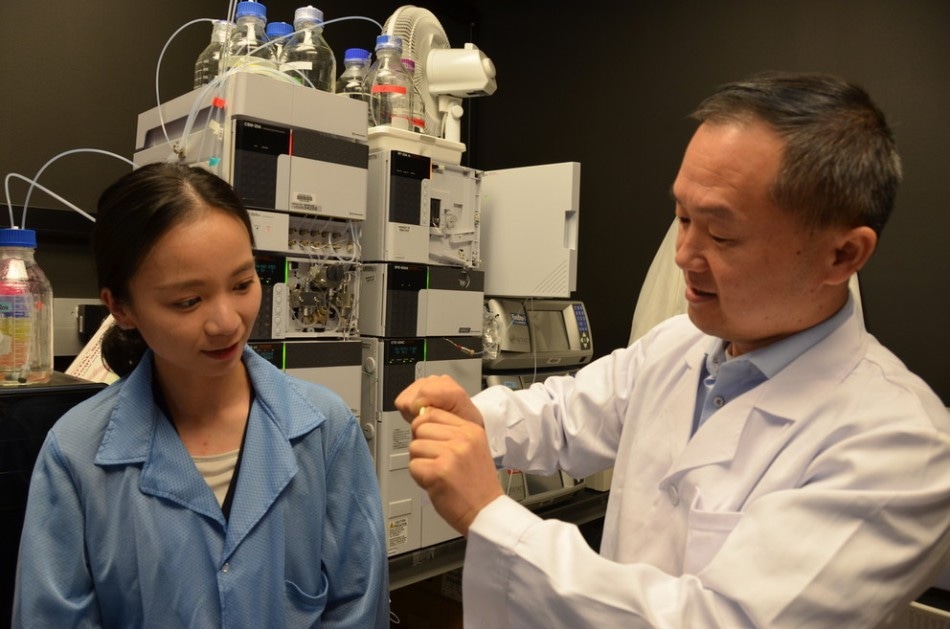Nov 27 2018
According to a group of Penn State bioengineers, a material based on a natural bone product and citrus fruit, known as citrate, offers the additional energy needed by stem cells to form new bone tissue.
 Jian Yang with PhD student Chuying Ma displaying a bendable citrate-based material for bone repair. (Image credit: Walt Mills/Penn State)
Jian Yang with PhD student Chuying Ma displaying a bendable citrate-based material for bone repair. (Image credit: Walt Mills/Penn State)
This latest insight into the mechanism that enables citrate to help in the regeneration of bones will allow the team to create biodegradable, slow-release, citrate-releasing scaffolds to serve as bone-growth templates to accelerate healing in the body.
In our lab, we have been working with citrate for over a decade. We knew that in the human body, 90 percent of organic citrate is located in skeletal tissue. But no one had really tried to use citrate as a building block to make bone biomaterials. Our new paper tries to understand how citrate helps in bone healing and uses the understanding to guide the design of new biomimetic biomaterials for better bone repair.”
Jian Yang, Professor of Biomedical Engineering, Penn State.
The results of the study have been reported in the Proceedings of the National Academy of Sciences.
Autografting is a procedure in which a bone is taken from another part of the patient’s body and grafted to the wound. While this method is mostly used for bone regeneration in hospital settings, it is not always a suitable approach, particularly when a bone tissue or large wounds are removed at the time of cancer treatment.
Artificial biomaterials can prove to be a welcome substitute, and in fact, many laboratories are working to develop them. However, existing artificial materials lead to major inflammation, and the rate of bone healing is slow. As a result, healing quality is invariably poor. The body encloses the implant with fibrotic tissues that make sure that the implant does not merge with the surrounding bone. Now, in the case of Yang’s material, the scientists did not observe encapsulation, and chronic inflammation was reduced to a large extent.
Chuying Ma is a doctoral student in Yang’s lab and is the paper’s lead author. She was given the task of exposing the sparingly known mechanism that underlies the body’s use of citrate in bone regeneration. She discovered that a transporter present in the stem cell membrane is used for transporting citrate into the cell to increase the cellular energy level. As the bone stem cells differentiate to form new bone cells, they require extra energy as support for the active formation of bones. Also, equally important are the dosage and timing of citrate supply to stem cells. The newly identified effect of the citrate on stem cell differentiation was dubbed as “metabonegenic regulation” by Ma and Yang in the paper.
The scientists also discovered that another factor was involved in the production of energy—an amino acid known as phosphoserine. With their recent insight into the mechanism for bone regeneration, the team devised a biomaterial that incorporates both phosphoserine and citrate and tested the same on rat models.
Using our new material, we see the early deposition of new bone at one month. This is much earlier than the biomaterials widely used in FDA-approved devices. In this study we tested two models, the femoral condyle bone and cranial bone defects.
Chuying Ma, Doctoral Student, Penn State.
Ma added that in both animal models, the novel biomaterial was found to be better in comparison to the commercial materials in inducing the early formation of bones and also encouraging the maturation of bones.
“To me, this is an important finding,” stated Yang, who is a faculty member in Penn State’s Materials Research Institute and the Huck Institutes of the Life Sciences. “Citrate is now recognized as a central linker between stem cell metabolism and differentiation. We are uncovering the mechanism whereby citrate influences stem cell activity, not only in bone, but by implication extending to other types of cells and tissues. For instance, there is a high concentration of citrate in the cerebrospinal fluid surrounding the brain. People can now use this understanding to start looking at citrate as a metabolism regulator to further regulate stem cells for other types of tissues and organs throughout the body.”
Together with Yang and Ma, other authors on the paper, “Citrate-based Materials Fuel Human Stem Cells by Metabonegenic Regulation,” are Jimin Kim, Dingying Shan, QiaolingLin, and Maria Hudock, all current or former students in Yang’s lab; and Xinggui Tian, Denghui Xie, Xiang Ao, and Xiaochun Bai, all of Southern Medical University, China.
The study was supported by the National Institutes of Health, a Cystic Fibrosis Foundation Research Award, and the National Natural Sciences Foundation of China.